Starting an online business sounds exciting, until you hit the roadblocks of coding, hosting, or figuring out complex backend systems. And that's where SaaS eCommerce platforms step in! They make it easier than ever for beginners and pros alike to launch, run, and scale a store without getting lost in the tech.
In this guide, we will explore the 15 best SaaS eCommerce platforms to help you kick off your journey with confidence:
- Shopify
- PrestaShop
- Wix
- Salesforce Commerce Cloud
- WooCommerce
- Adobe Commerce (formerly Magento)
- BigCommerce
- Squarespace
- Square Online
- commercetools
- Dynamics 365 Commerce
- Shift4Shop (formerly 3dcart)
- Big Cartel
- Volusion
- Helium 10
Let's get started!
What is SaaS eCommerce – All You Need to Know
SaaS eCommerce (short for “Software as a Service”) refers to a type of online selling platform where the software you use to run your store is hosted and maintained by a third-party provider. Instead of downloading and installing the software yourself, you simply pay a subscription fee to access it through the internet (just like using Netflix or Spotify, but for your online store).
Today, SaaS eCommerce is rapidly growing in popularity. More specifically, top SaaS eCommerce platforms like Shopify, BigCommerce, and Adobe Commerce alone now power over 70% of online stores, showing strong global demand. According to Hostinger, the broader SaaS industry is also booming, with the market projected to reach $1.25 trillion by 2034, growing at a 13% annual rate.
Together, these trends point to a clear direction: SaaS eCommerce is not just an option; it’s quickly becoming the standard for selling online.
How does SaaS eCommerce work?
With SaaS eCommerce platforms, you pay a monthly or yearly subscription to use a hosted platform that handles everything from storefront design to payment processing and customer management. Most SaaS providers offer different pricing tiers based on your business size, needs, or the number of features you want access to.

For example, a small business might start with a basic plan that covers essential tools, while a growing brand might upgrade to a mid-tier or enterprise plan with more customization options, advanced support, and integrations.
In most cases, these plans are fixed-rate, but some providers may offer custom pricing, especially for large-scale businesses with unique requirements.
SaaS vs open-source eCommerce
When exploring SaaS eCommerce platforms, it’s important to understand how they compare to open-source alternatives. Both approaches can power an online store, but they differ in how they’re hosted, customized, maintained, and supported.
Below is a side‑by‑side comparison to help you see the unique benefits and trade‑offs of each option so you can choose the best fit for your business.
Aspect | SaaS eCommerce | Open-source eCommerce |
Definition | Software hosted by a third-party provider, accessed via subscription. | Software whose source code is freely available for self-hosted use. |
Key differences | - All-in-one solution (hosting, updates, support included). - Fast to set up, minimal technical skill needed. - Vendor controls backend. | - Fully customizable with access to backend code. - Requires developer support for setup and maintenance. - You manage hosting & updates. |
Pros | - Fast launch with ready-to-use store templates. - Built-in eCommerce tools like payment gateways, shipping calculators, SEO, and analytics. - Technical support included. | - Unlimited customization possibilities. - Full ownership of platform and data. - Can integrate with any tech stack. |
Cons | - Limited ability to modify core platform features without vendor approval. - Advanced customizations may require relying on third-party apps or paid integrations. | - Requires technical knowledge to set up and maintain store. - No official support, you must rely on the community or hire developers. |
Best suited for | - Merchants who want a quick, hassle-free launch with built-in tools and ongoing support. - Businesses that prioritize stability and convenience over full customization. | - Merchants with unique product, checkout, or backend requirements. - Businesses with in-house technical expertise or budgets for custom development. |
Top 15 SaaS eCommerce Platforms 2025
With so many SaaS eCommerce platforms on the market, it can be hard to know which one truly fits your business. For this roundup, we looked beyond just popularity, focusing on platforms that offer the right balance of features, ease of use, scalability, and reliable customer support.
We also considered performance, security, and how well each option adapts to different business sizes and industries. This way, we can ensure that our top 15 SaaS eCommerce platforms are relevant for both new entrepreneurs and established online stores.
Note: All pricing in this list is based on U.S. rates and may vary in other regions.
1. Shopify

As one of the best SaaS eCommerce platforms, Shopify sets itself apart with powerful sales-driven tools that support businesses at every stage of growth. Its strength lies in how it helps merchants manage complex operations (e.g., syncing inventories across multiple channels or optimizing the checkout for higher conversions). Rather than just a place to sell, Shopify gives you the infrastructure to grow, backed by fast, secure hosting and a reliable backend.
Features:
- Multichannel selling across online stores, marketplaces, and social media
- AI-powered Shopify Magic for product descriptions and marketing content
- Shopify Sidekick – AI assistant for business management
- Abandoned cart recovery and discount codes from the Basic plan
- Over 100 supported payment gateways
- Customizable checkout experience
- 1,000+ apps for added functionality
- SEO tools, including Semrush-powered eCommerce Booster
- Built-in Shopify Shipping (US and Canada only)
- Shopify Tax for streamlined sales tax management
Pricing: Basic: $39/month | Shopify Pros | Shopify Cons |
+ Strong inventory and order management capabilities + Scalable for growing and large businesses + Advanced control over storefront design + 13,000+ apps available + Over 100 payment options | + Short three-day free trial + Expensive pricing plans compared to competitors |
Best for: Growing and established businesses with medium to large inventories that look to expand their operations and leverage powerful eCommerce features across multiple sales channels.
Read more: Shopify Review
2. PrestaShop
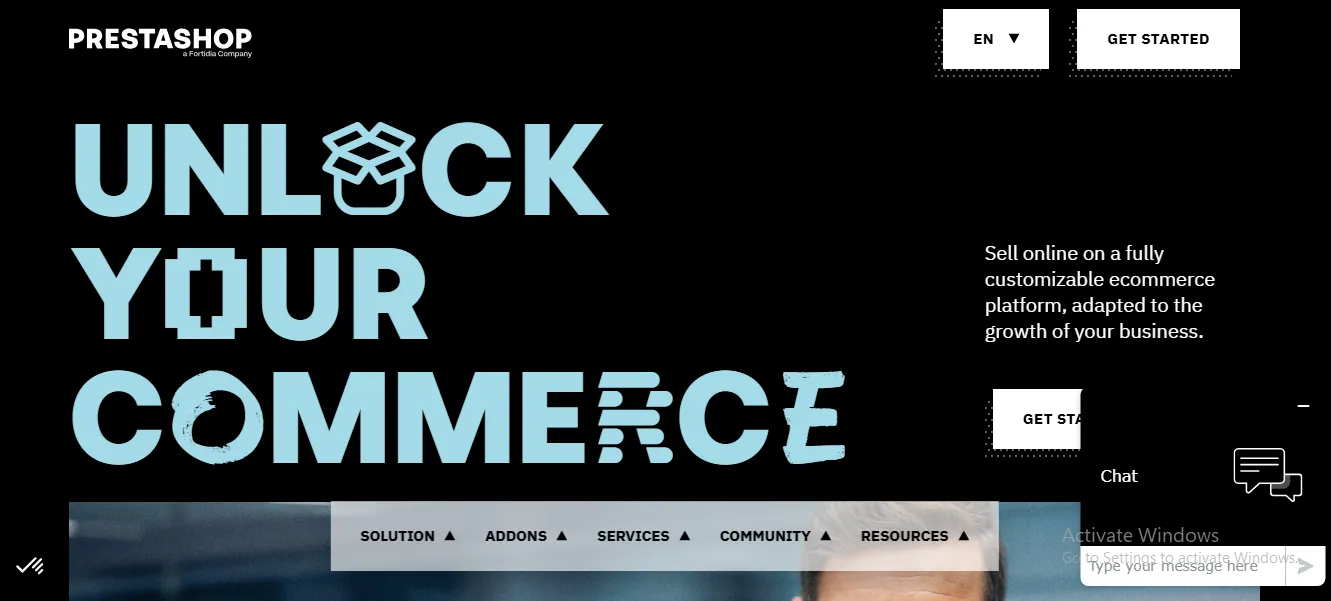
PrestaShop gives you the freedom to modify, expand, and optimize your store to match niche business needs.
Specifically, the platform offers two different versions: a completely free open-source edition and a hosted version with pre-configured settings. While the learning curve is steeper compared to drag-and-drop builders, the tradeoff is worth it for businesses that need advanced capabilities and long-term scalability without recurring fees tied to every feature.
Features:
- Fully open-source with complete code access and customization potential
- Over 2,000 modules and 800+ templates for expanded functionality and design options
- Built-in support for 75+ languages, multiple currencies, and international tax settings
- Product management with stock syncing, sales analysis, and third-party integration
- 250+ supported payment methods, including Stripe, PayPal, Klarna, and more
- SEO customization and 170+ additional SEO-focused modules
- Marketing e Commerce tools, including competitor analysis, multi-platform advertising, and PrestaShop Ads
- Active community forum, Help Center, PrestaShop Academy, and optional paid expert support
Pricing: Classic: Free download Hosted: From €24/month (~$25) Enterprise: Custom | PrestaShop Pros | PrestaShop Cons |
+ Intuitive eCommerce management dashboard + Professional, ready-to-use templates + Powerful cross-border eCommerce tools + Highly customizable through open-source access + Extensive marketing tools | + Many essential features require paid add-ons or modules, + No standardized quality across third-party modules + Security features are limited out-of-the-box |
Best for: Small to medium-sized businesses that want the flexibility of a customizable platform without the burden of managing hosting or technical setup.
Read more: PrestaShop review
3. Wix
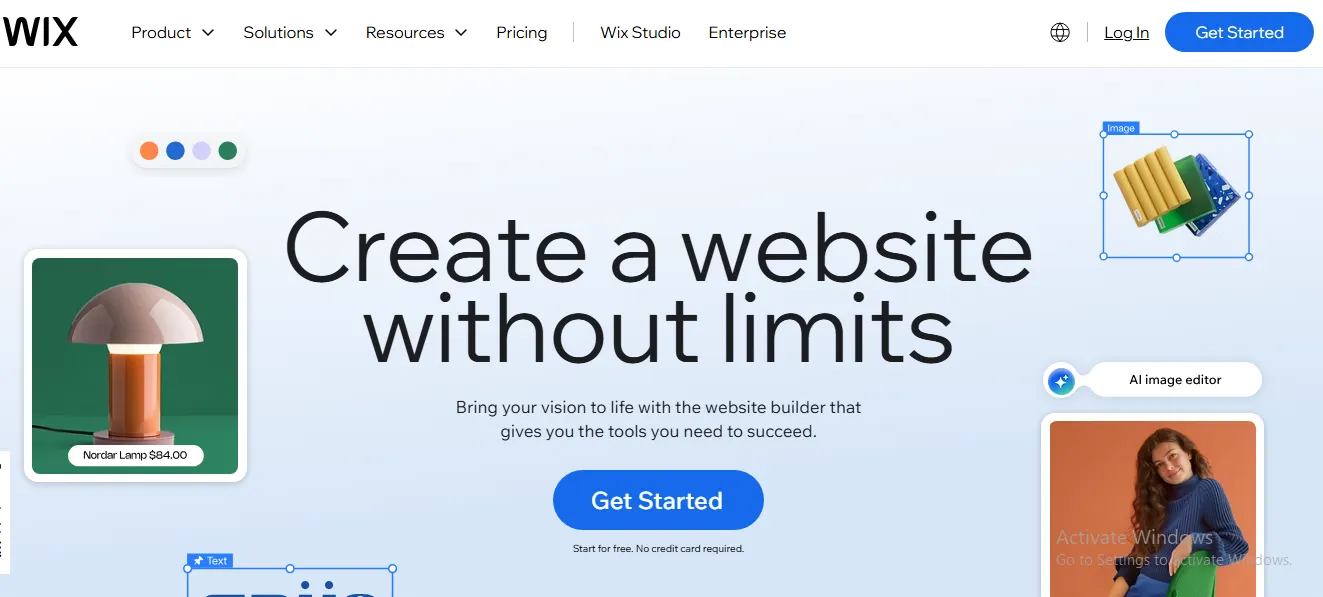
Other SaaS eCommerce platforms in the same pricing range often restrict users to rigid templates or basic design blocks, yet Wix allows near-pixel-level control. It lets you build websites that truly reflect your brand without touching a line of code! The platform also packs a robust app marketplace, advanced SEO tools, and business management features to cater to a wide range of users.
Features:
- Drag-and-drop editor with full design flexibility
- 2,000+ highly customizable templates across all industries
- AI tools for website design, text creation, SEO, blogging, and image editing
- AI Theme Assistant and chatbot for real-time design suggestions
- Built-in tools for blogging, video creation, email marketing, and social media content
- eCommerce capabilities with customizable product pages and AI-powered chat support
- App Market with 800+ third-party and native integrations
- SEO Setup Checklist with personalized guidance and keyword tracking
- Mobile app builder for custom-branded iOS/Android apps
- Centralized communication with Wix Inbox
Pricing: Light: $17/month Core: $29/month Business: $36/month Elite: $159/month | Wix Pros | Wix Cons |
+ Very affordable + Exceptional creative control and visual flexibility + AI-powered site setup and smart design suggestions + Wide selection of professional templates + Excellent built-in SEO tools with a personalized checklist + Helpful onboarding, tutorials | + Templates can’t be switched once the site is live + AI tools can occasionally be unstable or inconsistent + Mobile responsiveness requires manual tweaking for custom layouts + No email support; limited availability of live support depending on language + eCommerce features less robust than Shopify for large-scale stores |
Best for: Freelancers, creatives, service-based businesses, and small online shops that value full design freedom and want AI tools to streamline their workflow.
Read more: Wix review
4. Salesforce Commerce Cloud
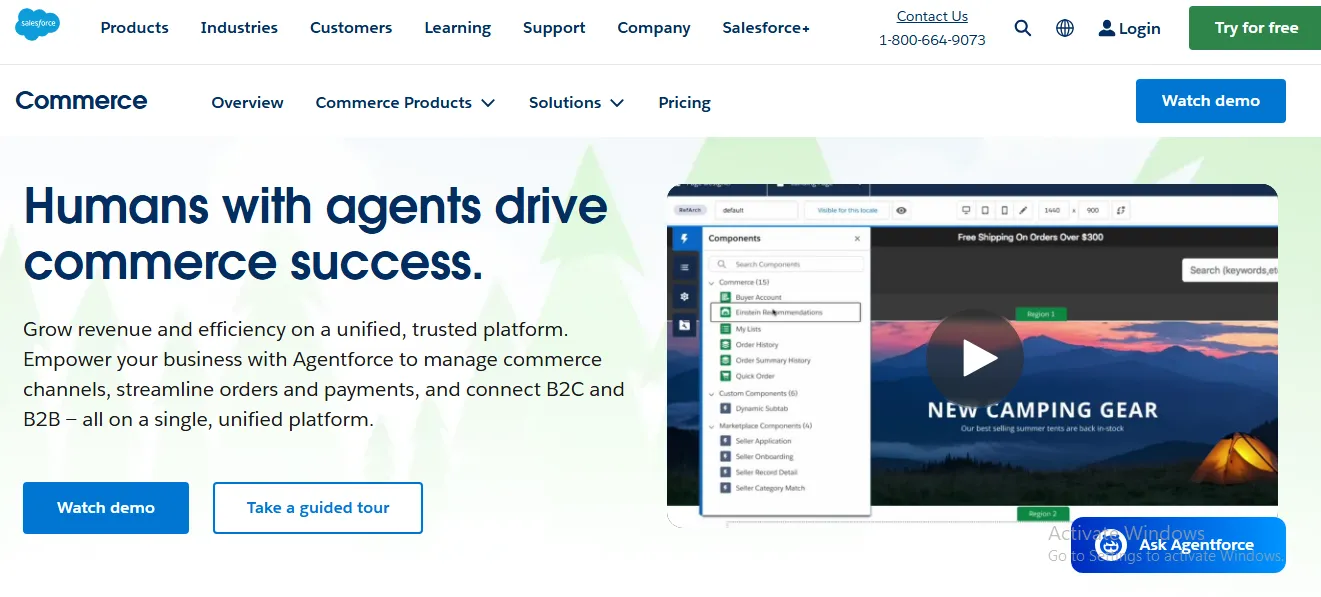
Next on our list is Salesforce, an enterprise-level ecosystem that connects sales, marketing, service, and commerce into a single, highly integrated platform.
Tools like Einstein AI, predictive lead scoring, and cross-department collaboration dashboards allow businesses not only to manage their customer data but to turn it into actionable strategy across every touchpoint. Furthermore, the platform also excels in delivering highly personalized customer journeys at scale.
Features:
- Comprehensive Sales Cloud with pipeline visibility, task automation, and productivity tracking
- Integrated Marketing Cloud with email, mobile, ad, and journey automation tools
- Service Cloud for centralized customer support across channels (chat, social, CTI)
- Commerce Cloud for managing digital storefronts, optimizing conversions, and integrating sales/service
- Einstein AI for predictive lead scoring, natural language search, and sales insights
- Real-time dashboards and analytics
- Extensive third-party integrations via AppExchange (9,000+ apps)
- Scalable multi-cloud architecture with cross-functional team collaboration
- Natural language processing for data queries and insights
Pricing: Growth: 1% GMV | Salesforce Pros | Salesforce Cons |
+ Highly scalable and customizable to complex workflows + Predictive AI tools (Einstein) for smarter sales and marketing decisions + Real-time performance tracking and cross-department visibility + Integrates with over 9,000 third-party tools and platforms + Strong security, uptime, and global accessibility + Centralizes all customer data and operations in one interface | + Higher pricing compared to most CRM/eCommerce platforms + Interface can feel outdated or overwhelming to new users + Standard support is basic; advanced support costs extra |
Best for: Large enterprises, B2B organizations, and fast-scaling companies with complex sales cycles, global customer bases, and cross-functional teams. They usually require deep integration between sales, marketing, support, and eCommerce operations.
Read more: Salesforce Commerce Cloud review.
5. WooCommerce
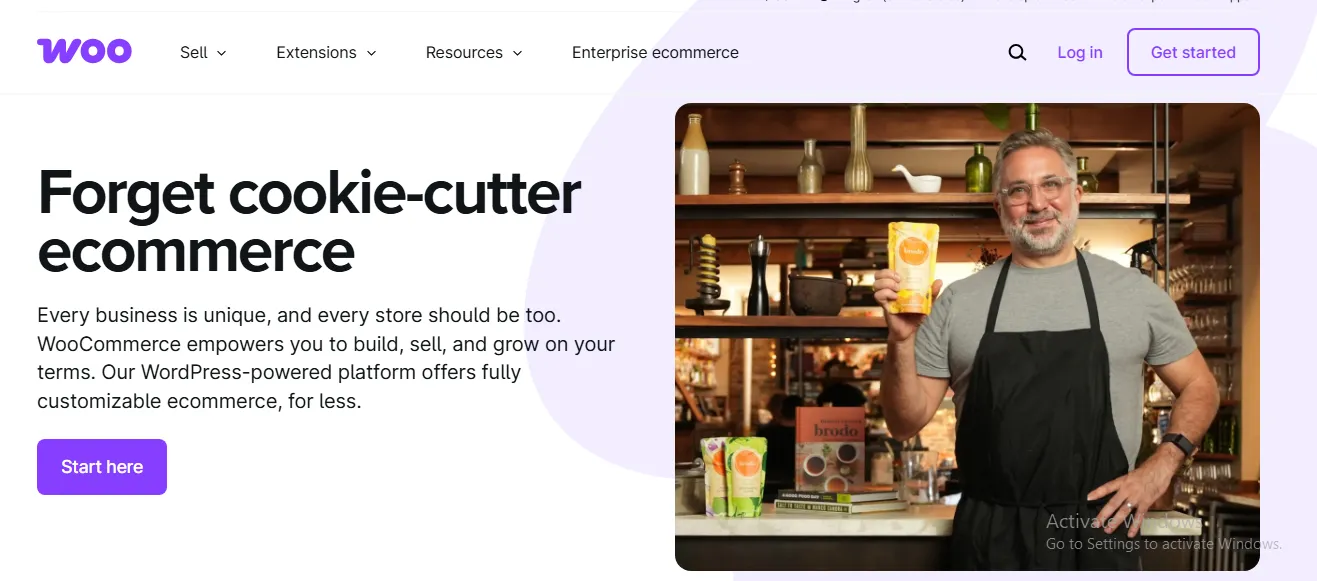
WooCommerce isn't an all-in-one package but more of a modular foundation for WordPress users. You choose the hosting, extend functionality through plugins, and shape the customer experience with thousands of available themes. Simply put, for anyone who wants to build a fully customized online store that grows with them, WooCommerce is among the best SaaS eCommerce platforms to make that happen.
Features:
- Seamless integration with WordPress for content-driven stores
- Selling both physical and digital products
- Coupon and discount system included
- Built-in product analytics and reporting (by date, product, category, etc.)
- Support for PayPal and WooCommerce Payments (powered by Stripe) out of the box
- 1,000+ compatible plugins for extended eCommerce functionality
- Full inventory control with bulk editing, stock tracking, and variations
- Gutenberg and other page builders for design flexibility
- Open-source nature for custom development and integrations
Pricing: Free (core plugin) | WooCommerce Pros | WooCommerce Cons |
+ Free to install and fully open-source + Huge plugin ecosystem to extend functionality + Deep integration with WordPress content and SEO tools + Bulk product editing and flexible product types | + No centralized customer support (support depends on plugins/themes/host) + Performance and ease of use vary depending on hosting and setup choices + Interface and dashboard can feel dated compared to modern SaaS platforms |
Best for: WordPress users, content-driven brands, or businesses with niche product requirements that demand full control over design, functionality, and hosting.
Read more: WooCommerce review
6. Adobe Commerce (formerly Magento)
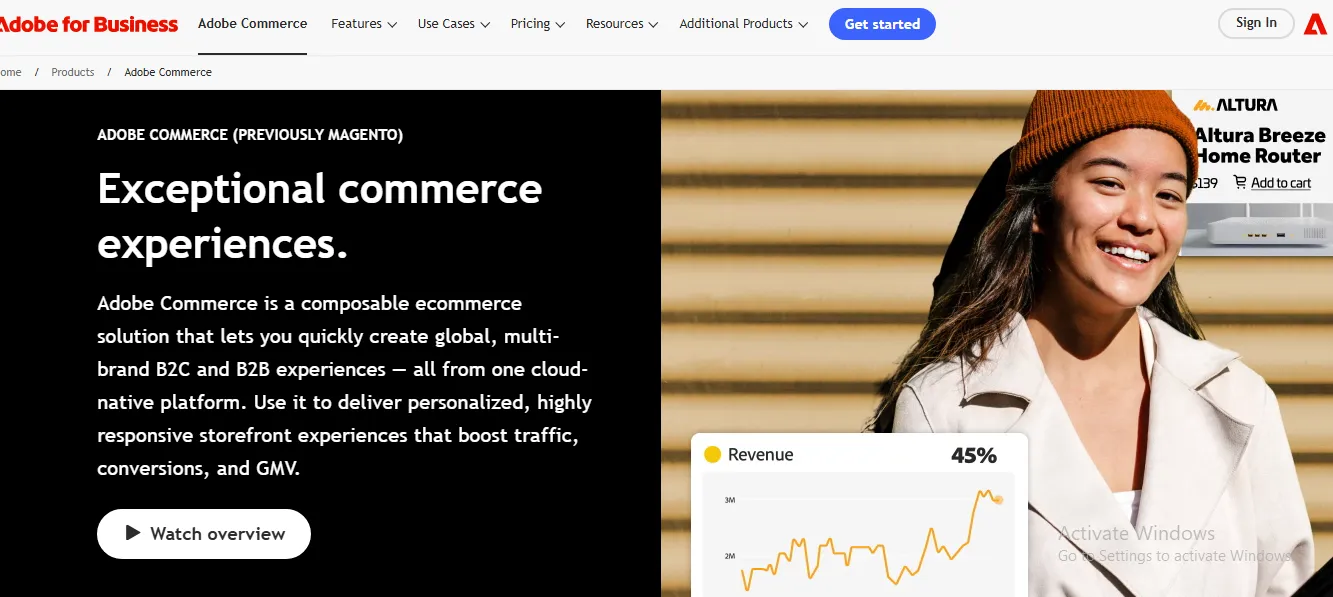
Formerly known as Magento, Adobe Commerce has evolved into a powerful cloud-based platform that merges deep customization options with AI-driven experiences and frictionless integration with the Adobe Experience ecosystem. Its strength in managing complexity (headless commerce, multi-brand environments, and advanced customer segmentation) separates Adobe Commerce from many other competitors.
Features:
- Multi-store and multi-brand management from a single backend
- AI-powered product recommendations and visual merchandising
- Integrated inventory, order, and fulfillment management
- Native B2B capabilities with custom pricing, catalogs, and customer portals
- Drag-and-drop page builder and PWA (Progressive Web App) studio
- Real-time analytics with Adobe Experience Cloud integrations
- Support for headless commerce with robust APIs
- Built-in SEO, mobile optimization, and global localization tools
- ERP and CRM integrations, including Adobe Analytics and Real-Time CDP
- Marketplace access to 4,000+ extensions for added flexibility
Pricing: Custom | Adobe Commerce Pros | Adobe Commerce Cons |
+ Designed for large-scale and complex B2B/B2C operations + Tight integration with the Adobe Experience Cloud (Analytics, Target, CDP) + AI-powered personalization and search built-in + Highly customizable with modular architecture and headless flexibility + Rich multi-site and multi-language support + Dedicated infrastructure and technical account manager (Pro plan) | + No transparent pricing + Steep learning curve for non-technical users + Heavily reliant on Adobe ecosystem for full feature value |
Best for: Large enterprises, global B2C/B2B brands, and complex multi-store operations that need omnichannel selling and tight integration with marketing and analytics tools.
Read more: Adobe Commerce review
7. BigCommerce
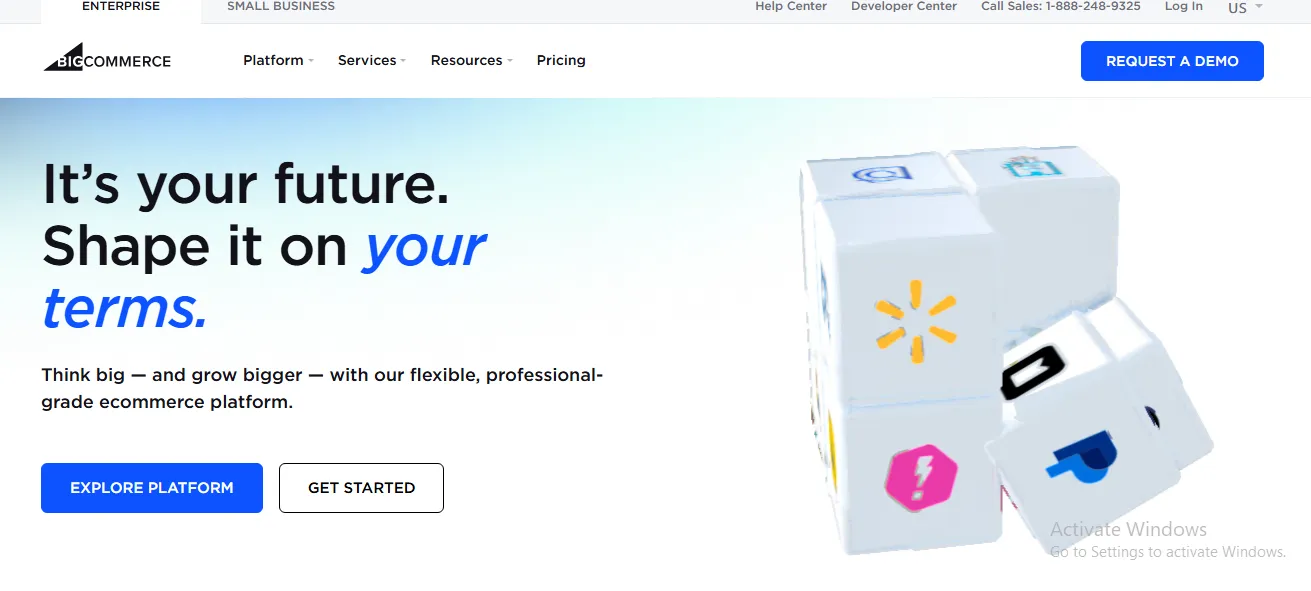
BigCommerce is the perfect SaaS eCommerce platform for businesses of all sizes, offering solutions that can grow and adapt alongside your ambitions. Its two distinct offerings ensure that every merchant finds the right fit. BigCommerce Essentials caters to small and medium‑sized businesses with accessible, professional‑grade eCommerce SaaS tools, while BigCommerce for Enterprise serves large‑scale operations.
No matter the model, BigCommerce equips merchants with powerful features such as customer segmentation, international selling tools, and multi‑channel integration, all in a user‑friendly environment that removes technical barriers. This ability to support both emerging entrepreneurs and global brands makes BigCommerce a standout choice for long‑term eCommerce success.
Features:
- Multi-channel selling (Amazon, eBay, Walmart, social platforms)
- Unlimited products, storage, and bandwidth
- Drag-and-drop page builder for storefront customization
- Customer groups & segmentation tools
- Abandoned cart saver (Plus plan and up)
- Built-in SEO and mobile optimization (Google AMP support)
- Integration with 65+ payment gateways
- Real-time shipping quotes and built-in shipping calculator
- App marketplace with 1,200+ integrations
- Support for international stores (multi-currency, multilingual, regional catalogs)
- POS integrations (Square, Clover, Heartland Retail, etc.)
Pricing: Standard: $39/month Plus: $105/month Pro: $399/month Enterprise: Custom | BigCommerce Pros | BigCommerce Cons |
+ No transaction fees on any plan + Excellent scalability with advanced features + Seamless multi-channel selling + Strong analytics and reporting tools + 1200+ third-party apps | + Editing interface can be complex for beginners + Pricey premium templates can be pricey + Key tools (e.g., abandoned cart saver) are locked behind higher-tier plans |
Best for: Mid-size to large businesses, B2B companies, or fast-growing online retailers that need advanced eCommerce capabilities, international selling, and multiple sales channels — all under one centralized platform.
Read more: BigCommerce review.
8. Squarespace

Squarespace focuses on premium design and frictionless user experiences, all within an interface that feels almost effortless to navigate. The Fluid Engine editor gives users more design control, while built-in AI tools simplify everything from building your site to running smart, effective marketing campaigns.
Features:
- 180+ professionally designed, mobile-responsive templates
- Drag-and-drop editing with the powerful Fluid Engine
- Built-in SEO tools and analytics
- Comprehensive blogging system with an AI writing assistant
- Fully integrated eCommerce with inventory management, shipping, and tax tools
- Acuity Scheduling for online appointment booking
- Email marketing and social media integrations
- Squarespace Blueprint AI for guided website creation
- Multilingual support and localized settings
Pricing: Personal: $25/month Business: $36/month Commerce Basic: $40/month Commerce Advanced: $72/month | Squarespace Pros | Squarespace Cons |
+ Sleek, high-end templates + Flexible design editor with strong visual customization + Robust built-in tools for blogging, scheduling, and eCommerce + AI tools for faster content creation and layout building + Strong customer support and learning resources | + No autosave feature when editing. + Some store elements (like headers/footers in older templates) cannot be edited + Limited layout flexibility for product and store pages + Amazon integration block is no longer supported (requires workarounds for affiliate links) |
Best for: Creative professionals, eCommerce service provider parties, and boutique eCommerce brands that prioritize design, branding, and ease of use over technical complexity.
Read More: Squarespace review.
9. Square Online

Since its release, Square Online has also been considered by many as one of the top SaaS eCommerce platforms. Instead of drowning users in complex customization tools, Square Online focuses on what matters most: seamless inventory management, smooth order processing, and effortless syncing between physical and digital sales channels. Plus, you still get access to strong branding options and useful analytics to keep your business moving forward.
Features:
- Seamless integration with Square POS for unified inventory and order management
- Free tier includes social media selling and payment processing
- Photo Studio app (iOS) for quick product photography and editing
- Unlimited storage and bandwidth on all plans
- API access and Square App Marketplace for third-party integrations
- Mobile-friendly design tools and storefronts
- Real-time shipping rate calculations (Premium plan)
Pricing: Free: $0 Plus: $29/month Premium: $79/month | Square Online Pros | Square Online Cons |
+ Extremely easy to use with fast setup + Fully integrated with Square POS for seamless offline-online syncing + Unlimited storage and bandwidth + Strong built-in tutorials and onboarding support + Competitive pricing with a free tier for entry-level sellers | + 24/7 customer support is only available on the highest-tier plan + Mobile app is iOS-only, limiting product photo editing options for Android users + Design customization options are more limited compared to design-heavy platforms + Lacks advanced tools for scaling or managing complex product catalogs |
Best for: Brick-and-mortar shops, restaurants, and service-based businesses already using Square POS — or small retailers looking for an easy, budget-friendly way to get online fast.
Read More: Square Online review.
10. commercetools

commercetools sets itself apart with a fully composable, microservice-based architecture that gives enterprise brands total control over every element of their commerce experience. Since there are no rigid templates or predefined workflows, you can innovate and scale while adapting fast to ongoing market changes.
Features:
- API-first, headless commerce framework
- Microservice-based architecture for independent deployment of features
- Use any front-end framework or tech stack
- Support for complex catalogs, pricing, and product structures
- Custom promotion and discount logic with advanced rule creation
- Integration-ready ecosystem with 50+ tools via Integration Marketplace
- Scalable infrastructure designed for global enterprise traffic
- Cloud-native performance and automatic scaling
Pricing: Custom (starts around $50,000/year) | commercetools Pros | commercetools Cons |
+ Unmatched flexibility for large-scale customization + Architecture built for speed and scalability + Freedom to use any front-end or back-end tech + Supports unique or complex business models | + Extremely steep learning curve; not beginner-friendly + Requires a strong in-house development team or costly external support + No out-of-the-box visual site builder or templates + Significant upfront and ongoing investment needed |
Best for: Enterprise-level businesses with unique requirements, complex product structures, or omnichannel strategies. Especially recommended for those with dedicated dev teams looking to build highly customized commerce solutions from the ground up.
11. Dynamics 365 Commerce

Dynamics 365 Commerce shines as a powerful, end-to-end retail solution built for large enterprises aiming to bring their online and in-store experiences together in one seamless system. What truly sets it apart from other SaaS eCommerce platforms is its deep, native integration with the Microsoft ecosystem (e.g., Azure, Power BI, and the full Dynamics 365 suite), paving the way for centralized control across every touchpoint.
Features:
- Unified management of online and in-store operations
- Seamless integration with Microsoft tools (Azure, Power BI, Dynamics 365)
- Basic customer segmentation and targeted promotions
- Centralized inventory, order, and customer data management
- Supports loyalty point earning and redemption across channels
- Analytics and reporting via Power BI integration
Pricing: eCommerce: $210/user/month eCommerce (+ add-ons): | Dynamics 365 Pros | Dynamics 365 Cons |
+ Strong integration with Microsoft products + Scalable infrastructure suited for enterprise-level operations + Fast implementation for core loyalty and retail features + Centralized system to manage both online and offline channels + Unified analytics through Power BI | + High cost, especially for eCommerce and advanced add-ons + Complex integration with non-Microsoft platforms + No dedicated technical support unless arranged separately |
Best for: Large retail enterprises already using Microsoft’s ecosystem. Tailored for those seeking a unified platform to manage inventory, operations, and customer data across digital and physical channels.
12. Shift4shop (formerly 3dcart)

Shift4Shop (formerly 3dcart) has earned its place as a feature-rich, technically advanced eCommerce platform. Its robust backend infrastructure stands out with lightning-fast processing speeds, strong SEO performance, and smooth third-party integrations that make it a true workhorse for serious businesses.
Features:
- No transaction fees or contracts
- 100+ responsive, mobile-optimized templates
- 200+ built-in features including CRM, affiliate marketing, and coupons
- Advanced email marketing and autoresponders
- SEO-optimized blog and on-site SEO tools
- REST API and developer-friendly backend
- Built-in POS system
- Integration with major marketplaces (eBay, Amazon, Facebook, Google Shopping)
- Supports 100+ payment gateways
- Unlimited product storage and built-in reports
- 24/7/365 support via phone, chat, and email
Pricing: $29 to $299/month | Shift4shop Pros | Shift4shop Cons |
+ Extensive built-in feature set across all plans + No transaction fees, which helps protect profit margins + Scalable infrastructure with strong SEO and multichannel tools + In-house CRM, blog, affiliate, and email marketing systems | + Steep learning curve due to complex backend and feature overload + Template designs feel outdated and may not appeal to modern users + Upgrading and long-term maintenance can be challenging |
Best for: Mid-sized to large online retailers, tech-savvy entrepreneurs, or businesses with in-house developers who want full control over their store’s infrastructure.
13. Big Cartel

Big Cartel takes a boldly different approach from similar SaaS eCommerce platforms by choosing not to chase scale. Rather than piling on advanced features or upselling you into complex workflows, it’s intentionally built for small stores that want to keep things personal, affordable, and under control. It champions the idea that not every business wants —or needs — to grow into something bigger.
Features:
- Pre-designed mobile-responsive themes (free with all plans)
- Inventory tracking and product management
- Sales tax automation (via TaxJar)
- Order tracking and shipping label printing
- Discount codes and promo management
- Stripe, PayPal, Square, and Venmo payment integrations
- Subscriptions support (via Stripe)
- Zapier integration for connecting with 5,000+ third-party apps
- Dropshipping supported through Printful and The Art of Where
- Basic SEO tools and real-time stats dashboard
Pricing: Gold: $0/month Platinum: $15/month Diamond: $30/month | Big Cartel Pros | Big Cartel Cons |
+ Extremely easy to set up and use + Free plan available with no listing or transaction fees + Visually clean, minimalistic store designs + Integrates with popular print-on-demand and subscription tools | + Limited to 500 products, even on the highest plan + No built-in abandoned cart recovery or blogging tools + Basic SEO and marketing capabilities + Email-only customer support with limited availability + Minimal customization unless you use code |
Best for: Independent artists, makers, and hobbyist sellers who want a simple, visually appealing storefront to sell a limited range of products without needing advanced features or marketing automation.
Read more: Big Cartel review.
14. Volusion

Volusion may not be the flashiest platform in 2025, but it keeps its offering focused on core store management: streamlined inventory control, mobile access, and a clean interface that gets the job done. Also, one of the standout advantages is that it charges no transaction fees on any plan, which can translate into significant savings for stores with high sales volumes.
Features:
- Step-by-step store setup with user-friendly dashboard
- Inventory management with upselling tools (e.g., suggested products via video)
- Premium one-step/two-step checkout to reduce cart abandonment
- 30+ payment gateways including Stripe, PayPal, and in-house Volusion Payments
- Shipping integrations with ShipStation and Shippo
- Customizable invoices and packing slips
- Mobile app for on-the-go store management
- Integration with Zapier for process automation
- Basic SEO tools and built-in discount/marketing functions
Pricing: Personal: $35/month Professional: $79/month Business: $299/month Prime: Based on GMV | Volusion Pros | Volusion Cons |
+ No transaction fees, ideal for high-revenue stores + Easy-to-use dashboard with beginner-friendly setup + Premium Checkout helps improve conversions + Solid mobile app and Zapier integration for flexibility + Good support access on higher-tier plans | + No support for selling digital products + Limited design flexibility and outdated theme editor + No blogging feature + Extra fees for bandwidth overages + Lacks advanced AI tools and next-gen ecommerce features + Annual sales limits may lead to unexpected plan upgrades |
Best for: Small to mid-sized retail businesses selling physical products with predictable sales volume.
Read more: Volusion review.
15. Helium 10

Helium 10 has become a common choice for Amazon sellers, offering a suite of 30+ tools that support every step of the selling journey. Its Chrome extension is also another game-changer compared to other SaaS eCommerce platforms, which gives instant access to real-time product and keyword data while you browse Amazon.
Features:
- Customizable dashboard with insights on revenue, orders, keyword rank, and ROI
- Powerful keyword research tools (Cerebro & Magnet)\
- Advanced product research filters (Black Box suite)
- Listing optimization tools (Frankenstein, Listing Analyzer, AI Listing Builder)
- Real-time keyword tracking and competitor analysis
- Market research and sales trend tools (Market Tracker & Market 360)
- Adtomic PPC campaign manager with automation and scheduling
- High-performing Chrome Extension for browser-based data access
- Free and premium training resources (PPC Academy, Freedom Ticket)
Pricing: Starter: $39/month Platinum: $79/month Diamond: $229/month | Helium 10 Pros | Helium 10 Cons |
+ Industry-leading data accuracy for Amazon-specific insights + Custom dashboards simplify daily performance monitoring + Chrome Extension delivers instant insights while browsing Amazon + Excellent customer support and in-tool training resources + No limit on keyword results per report | + Starter plan lacks core tools and provides limited value + Steep learning curve, especially for new sellers + Add-ons can significantly raise the overall cost + No onboarding setup; manual account linking required |
Best for: Amazon FBA and FBM sellers (especially intermediate to advanced users or growing teams) who rely heavily on data to make product and keyword decisions.
Which SaaS eCommerce Platform is For Your Business?
Every merchant has different priorities, some need simplicity, others demand power and flexibility. That’s why no single SaaS eCommerce platform fits everyone. To help you decide, we’ve grouped our recommendations based on business size, goals, and selling style.
For beginners and small businesses, we recommend:
- Wix: Easy drag‑and‑drop editor with full design freedom and AI tools for quick setup.
- Squarespace: Premium, design‑focused templates and all‑in‑one simplicity.
- Square Online: Perfect for brick‑and‑mortar stores using Square POS.
- Big Cartel: Minimal, affordable option for artists and hobby sellers.
For growing businesses and mid‑size retailers, we recommend:
- Shopify: Scalable, multi‑channel selling with a huge app ecosystem.
- BigCommerce: Flexible, feature‑rich platform with versions for both SMBs and enterprises.
- PrestaShop (Hosted): Customizable, budget‑friendly option without managing your own hosting.
- Shift4Shop: Feature‑rich with no transaction fees.
For large enterprises or complex eCommerce operations, we recommend:
- Adobe Commerce: Deep customization and advanced multi‑store management.
- Salesforce Commerce Cloud: Integrated sales, marketing, and service tools with strong personalization.
- Commercetools: Headless, composable architecture for total control.
- Dynamics 365 Commerce: Best for Microsoft‑centric enterprise ecosystems.
For creative professionals and niche brands, we recommend:
- Wix: Highly flexible design control for creative portfolios and shops.
- Squarespace: Elegant templates perfect for visually led brands.
- Big Cartel: Minimal, artistic storefronts with straightforward selling tools.
SaaS eCommerce Platforms: FAQs
What is the SaaS platform for eCommerce?
A SaaS eCommerce platform is an online store-building solution that you access through a subscription, rather than installing or hosting it yourself. The provider takes care of everything behind the scenes (like security, hosting, software updates, and technical support) so you can focus on selling.
Which is the best SaaS eCommerce platform?
Shopify is often considered the most well-rounded for most businesses. It’s beginner-friendly, powerful enough for scaling brands, and has a huge app marketplace for added features.
On the other hand, other platforms still shine in specific areas:
- BigCommerce offers more built-in features and is great for scaling fast.
- Wix or Squarespace are ideal for small stores focused on design and ease of use.
- Shift4Shop (formerly 3dcart) is a strong choice for tech-savvy sellers who want more control without paying transaction fees.
Is Shopify a SaaS platform?
Yes, Shopify is a SaaS (Software as a Service) eCommerce platform. You don’t need to install or host anything on your own; Shopify provides everything, including web hosting, security, and continuous updates.
Are eCommerce sites SaaS?
Some eCommerce sites are powered by SaaS platforms, but not all. SaaS eCommerce platforms like Shopify, BigCommerce, and Wix host and maintain the software for you, allowing you to run your store through a subscription model. Other eCommerce sites may be built on open‑source or custom solutions, which are self‑hosted and not considered SaaS.
Is Amazon a SaaS platform?
No, Amazon’s main marketplace (Amazon.com) is not a SaaS platform. It’s an online marketplace where third‑party sellers list and sell products to customers. However, Amazon does offer SaaS products in other divisions, such as Amazon Web Services (AWS), which provides cloud‑based tools and infrastructure.
Final Words
And there you have it, the 15 best SaaS eCommerce platforms that are redefining how people build and grow online stores. Each platform has its own unique perks, so take your time to explore and choose the one that best fits your business goals.
For more tips and insights, head over to the LitExtension blog or join our Facebook Community.

